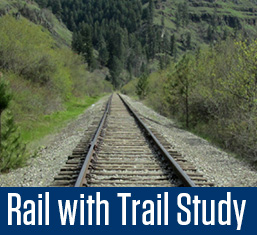WURA to receive trail study report in December
WURA to receive trail study report in December
Rocky Wilson
Wallowa County Chieftain
Published:February 10, 2015 5:32PM
Other than the economic impact assessment intended to be completed by now, work on the EOU student/Oregon Department of Parks and Recreation feasibility study for the proposed Rail With Trail project is on schedule.
Although the number of players is not large, Rails With Trail feasibility study Project Manager Dana Kurtz says, as a whole, work on that project is proceeding on schedule and she anticipates a final report will be shared with the Wallowa Union Railroad Authority (WURA) at that group’s December 2015 meeting.
Kurtz is a graduate student at Eastern Oregon University and her counterpart on the study where invested time far exceeds invested dollars, Oregon Department of Parks and Recreation Trails Coordinator Rocky Houston, feels the effort is on pace as well.
According to Kurtz, the only element of the study currently lagging behind schedule is an economic impact assessment, and two students working on that portion of the study plus two economics professors from EOU will present early findings on the matter to a Student Internship Advisory Committee on Feb. 11. One month beyond that and the same foursome will announce the findings of their work.
Houston suggests those results will include some potential construction costs and potential use levels for the proposed trail.
A man who has spent years working with State Parks to design and develop public trails throughout the state, Houston has no interest in voicing an opinion about whether the proposed 63-mile trail beside the rails between Elgin and Joseph could happen. “I just want us to get through the conceptual planning,” he says. “I look no further than December.”
WURA owns the railroad line and has made it clear from the start that, among other things, all decisions in regard to a proposed trail will be made by the WURA board of directors, that the rails will remain in the ground, and that WURA will incur no expenses in the construction of any future trail.
According to Houston, some answers to questions most frequently asked by the public will not be addressed until the final report, if at all. Common concerns he has heard include what the total cost of such a trail would be, where money would come from to finance the undertaking, and what steps would be taken long-term to maintain the trail.
And yet, says Houston, “there are many, many ways to move forward.”
Unknowns still to be addressed include whether the trail would vary in width at different locations, whether it would include all or part of the 63 miles, the level of volunteerism that would be required to make the effort feasible, and much more.
Still, says Kurtz, much work has been accomplished on the feasibility study since the effort was launched last summer. Among those things, she says, was a push to interview 26 persons; a land use assessment; a main street assessment; a cultural and historic properties assessment; and a physical rail corridor assessment. All of the information compiled during those studies is available for public review at https://www.eou.edu/rails-with-trails.
Terry Edvalson, an active participant in the Rails With Trail push since its inception, says at least one survey again to explore public interest on the bi-county trail issue will be circulated in either April or May. Houston is hoping there will be two separate surveys in March or April — a general survey and a scientific, random survey.
Were results from the feasibility study, when presented in December, to lead the WURA board to determine it wished to move forward with the construction of a trail alongside the railroad line, Houston suggests grant money from such sources as state and federal governments, the Oregon Department of Transportation, private sources, and foundations might be tapped to help foot the bill.
“But,” says Houston, “it’s all about public sentiment and patience.”
